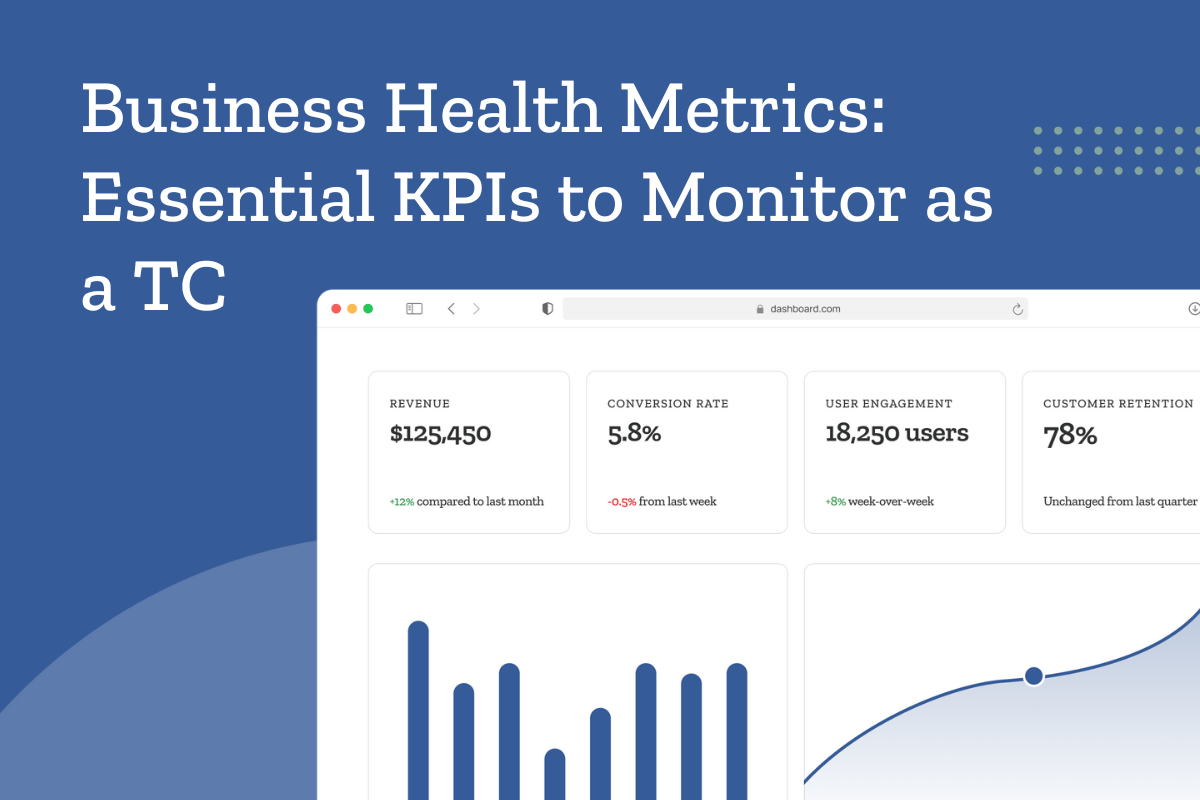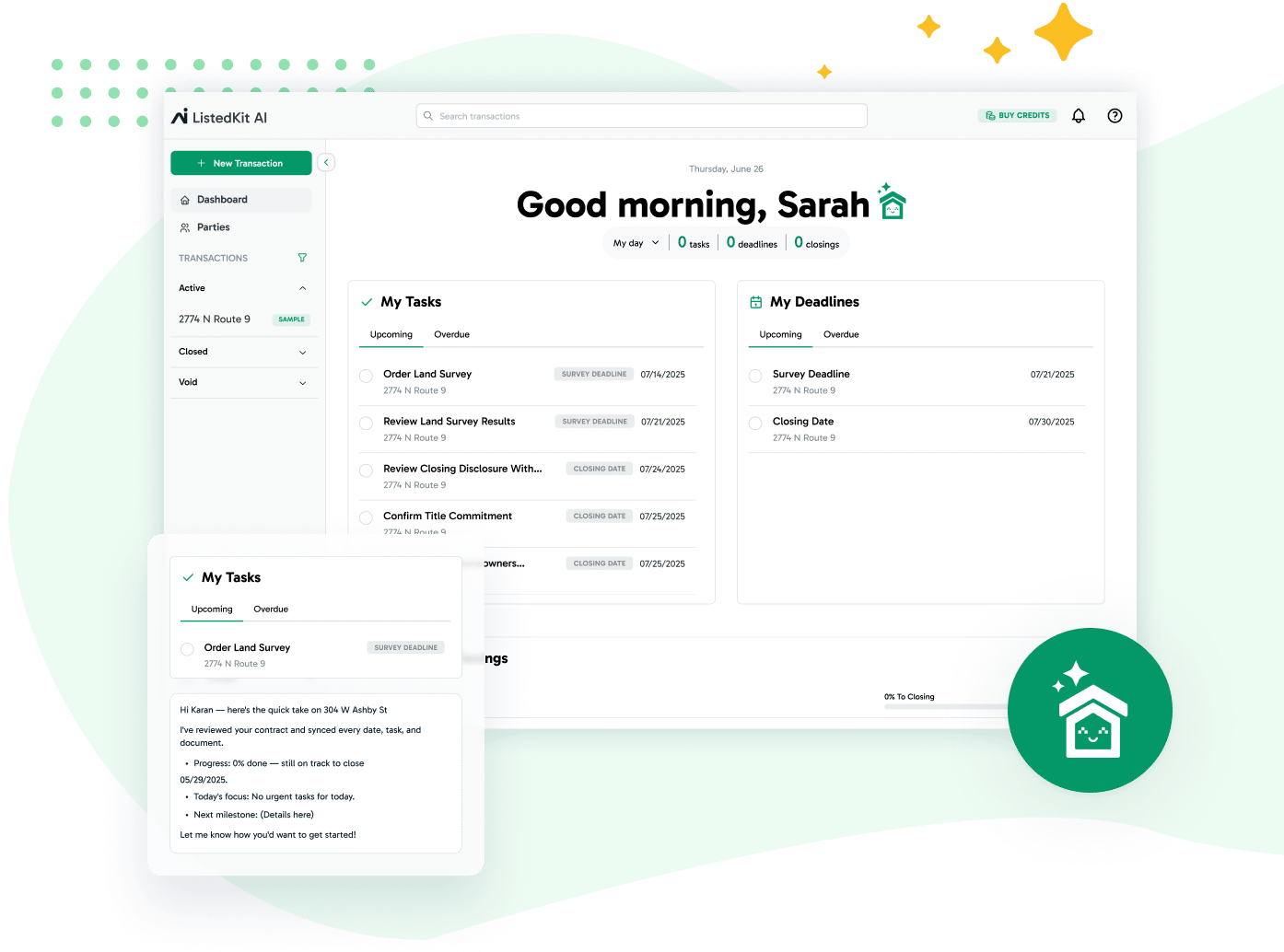Tracking business metrics is essential for transaction coordinators to stay efficient and grow. Measuring key performance indicators (KPIs) quarterly can help spot trends, improve processes, and plan ahead.
This article offers practical steps and real-world examples to help you focus on what matters most. You’ll learn how to track and use these numbers to improve how you work and meet your business goals.
What Are Business Health Metrics?
Business health metrics refer to the extent of the functioning of a business during a certain time. As a transaction coordinator, these metrics give you further insight into how well you are closing deals, keeping clients, and managing revenue.
Through monitoring certain key performance indicators on a quarter-to-quarter basis, such as customer satisfaction scores and average days to close, you will be able to recognize trends and take action before minor problems turn into major ones.
This approach helps you make decisions based on data that support enhancement in overall financial performance and business success.
For example, your customer retention rate decreases over three months. This could signal that existing customers are increasingly dissatisfied due to slower response times or even a lack of follow-up post-transaction.
You go through performance metrics, find the problem, and implement a strategy that will improve communications or set expectations at the point of transaction.
In that sense, you retain more of your customer base, improving overall experience and creating happier customers with more successful transactions.
Essential Metrics for TCs: Breaking Down Key Categories
Tracking essential metrics is non-negotiable for running a successful transaction coordination (TC) business. These metrics fall into three key categories—operational, financial, and client satisfaction—and provide a full picture of your business health.
Let’s explore these in more detail.
Operational Metrics
- Total Closed Escrows. Tracking the number of closed escrows every quarter reveals your business’s performance trends. Are closings steadily increasing? A consistent upward trend suggests growth, improved processes, and a strong sell-through rate. For instance, if your data shows a dip in closings during the summer, it may indicate seasonal slowdowns or inefficiencies in your workflow.
- Total Pending Escrows. Pending escrows signal future revenue and workload. A healthy balance between pending and closed escrows shows your business handles transactions sustainably. Monitoring this metric ensures you allocate resources effectively and avoid bottlenecks in busy months.
- Average Days to Close. The fewer days it takes to close an escrow, the better for your clients and business. Delays in this area can lead to customer dissatisfaction and even cancellations. Reducing the average time to close increases customer satisfaction scores, improves operational efficiency, and enhances your reputation.
Financial Metrics
- Estimated Gross Income. Your gross income is a clear indicator of financial health. Tracking this metric helps you gauge revenue growth over time. For example, if gross income increases without a matching rise in operational costs, your profit margins are improving—a sign of a more efficient business model.
- Cancellation Percentage. A high cancellation percentage can undermine financial performance. It might signal poor communication, unclear expectations, or other avoidable issues. Keeping cancellations below industry benchmarks protects your cash flow and retains more of your customer base.
Client Satisfaction Metrics
- Repeat Clients as a Percentage of Total. Client retention is one of the most telling signs of your business’s health. If a growing percentage of your transactions come from repeat clients (i.e., real estate agents), you meet or exceed expectations. This metric ties directly into customer satisfaction and long-term business success.
- Net Promoter Score (NPS). NPS surveys allow one to collect information regarding how happy customers are. A high NPS reflects not only the satisfaction of clients but also potential recommendations, which lowers your client acquisition cost and grows the client base without additional advertising expenses.
Connecting Metrics to Business Health
Operational, financial, and client satisfaction metrics are interconnected. For example, an increase in average days to close can negatively impact customer satisfaction and result in fewer repeat clients.
Tracking these metrics together allows you to spot patterns, adjust strategies, and work toward long-term stability and growth.
Practical Tracking Methods for Key Metrics
Accurately tracking key performance metrics is simpler than it seems, especially with the right tools and strategies. Effective tracking helps you uncover trends, address potential issues, and make decisions that keep your business on track. Here’s how you can do it:
Tracking Total Closed and Pending Escrows
Tracking your total closed and pending escrows ensures you stay on top of your workload and revenue potential. Tools like Excel or Google Sheets are perfect for this.
- Use separate tabs for each quarter: For instance, you can create sections for January through March to track closed and pending escrows like in the spreadsheet above.
- Automate calculations: Simple formulas can calculate totals and trends automatically. For example, a formula like =SUM(B2:B13) adds all closed escrows in a column for a quarterly summary.
- Visualize trends: Insert charts to display pending and closed escrow trends over time, helping you identify slow or busy periods.
By reviewing trends quarterly, you can adjust your workflows to avoid bottlenecks or gaps in workload.
Monitoring Gross Income and Cancellation Rates
Gross income and cancellation percentages are essential metrics for financial health.
- Track income monthly and quarterly: Add a column in your spreadsheet for gross income, breaking it down by month and quarter.
- Use graphs to highlight growth patterns: Bar or line charts can show whether your revenue aligns with your business goals.
- Calculate cancellation rates with a simple formula: Use (Cancelled Escrows ÷ Total Escrows) × 100 to track the percentage of cancellations. For example, if you have 1 canceled escrow out of 10, your cancellation rate is 10%.
Identifying spikes in cancellations can help you address underlying issues, such as delays or unclear expectations before they impact your revenue.
Quarterly Benchmark Trends and What to Expect
Tracking quarterly benchmarks helps transaction coordinators (TCs) monitor their progress, adapt strategies, and stay competitive. You can align your metrics with meaningful business goals by focusing on operational, financial, and client satisfaction trends.
Operational Metrics
- Growth Phase:
- Expect a steady rise in pending escrows as your business expands.
- Example: If you have three pending escrows in January and six by March, it signals growth, but you’ll need to ensure your processes can handle the increased volume.
- Track average days to close to avoid delays as your workload grows.
- Established Businesses:
- The goal shifts to maintaining consistent escrow volumes to sustain cash flow.
- A drop in pending escrows may indicate a need for stronger partnerships with agents or marketing outreach.
Financial Metrics
- Gross Income:
- Should rise in sync with transaction volume.
- Example: If you close 12 escrows in Q1 at an average of $1,000 per escrow, your gross income for the quarter should reflect that growth.
- If gross income lags behind, review potential issues like cancellations or inefficiencies increasing operational costs.
- Cancellation Percentage:
- Keep this below industry benchmarks to avoid financial losses.
- Review quarterly cancellation data and address trends, such as delays or miscommunication, to lower this rate.
Client Metrics
- Customer Retention and Satisfaction:
- Positive reviews and referrals signal good service and operational efficiency.
- Example: If client feedback improves each quarter (e.g., 4.2/5 in Q1 to 4.5/5 in Q2), it suggests better communication and service delivery.
- Net Promoter Score (NPS):
- Use quarterly NPS surveys to measure customer satisfaction.
- A rising NPS indicates more satisfied clients, reducing churn and boosting repeat business.
Practical Benchmarks to Track
- Pending escrows should grow steadily during growth phases.
- Average days to close should gradually decrease, reflecting improved efficiency.
- Gross income should consistently rise without a corresponding spike in cancellations.
- Client satisfaction and retention rates should remain high, with repeat clients making up a growing percentage of your total.
Adapt Your Benchmarks
Benchmarks evolve as your business grows. For example:
- A TC handling five transactions per quarter may focus on reducing days to close by automating workflows.
- A larger operation closing 30 transactions may prioritize maintaining quality while scaling service.
Revisit benchmarks regularly to match your current performance and strategic goals. Tracking and adapting keeps your KPIs actionable and relevant.
Avoiding Common Mistakes in KPI Tracking
While tracking metrics is essential, it’s easy to fall into common traps. Avoid these pitfalls to ensure effective monitoring:
- Focusing on One Metric Alone. Overprioritizing a single metric, like gross income, can lead to ignoring other critical metrics, like client satisfaction or operational efficiency.
- Overcomplicating Tracking Systems. Stick to simple, intuitive methods or tools to avoid confusion and wasted time.
- Ignoring Trends. Data should drive business decisions. Regularly reviewing trends ensures you’re adapting to real-time changes.
By staying consistent and avoiding overwhelm, you’ll maximize the impact of KPI tracking.
Turn Insights Into Impact: Build a Healthier TC Business
Tracking quarterly metrics is one of the smartest moves you can make as a transaction coordinator. These numbers aren’t just data points—they’re tools to help you identify patterns, improve processes, and plan strategically.
Here’s a summary of the key metrics to track:
- Total Closed Escrows: Measure how many transactions are successfully completed each quarter.
- Total Pending Escrows: Monitor future workload and revenue opportunities.
- Average Days to Close: Track the time it takes to close transactions and aim to reduce it.
- Estimated Gross Income: Evaluate revenue growth over time.
- Cancellation Percentage: Identify and reduce the percentage of canceled transactions.
- Repeat Clients as a Percentage of Total: Track how many clients return for repeat transactions.
- Net Promoter Score (NPS): Measure client satisfaction and likelihood of referrals.
Take the next step in building a healthier TC business. Sign up for our newsletter to get actionable insights, updates, and recommendations.




